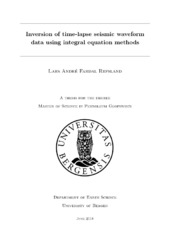Inversion of time-lapse seismic waveform data using integral equation methods
Master thesis
Permanent lenke
https://hdl.handle.net/1956/18123Utgivelsesdato
2018-06-20Metadata
Vis full innførselSamlinger
- Department of Earth Science [1050]
Sammendrag
Time-lapse seismic data are considered a valuable tool for monitoring hydrocarbon reservoirs. Since the changes in elastic parameters associated with production of hydrocarbons, or injection of CO2 into a reservoir, tend to be relatively small compared to that of the geological surroundings, scattering integral equation methods have been chosen for the task of modelling time-lapse seismic data. Full waveform inversion (FWI) is a comprehensive imaging technique that employs all of the information contained in seismic data, including travel times, amplitudes, internal multiples and diffractions. This was first performed using the distorted Born iterative T-matrix (DBIT) method, an iterative inversion approach that solved linear inverse problems at every iteration. This method has been performed on two models. Two time-lapse experiments was performed using a sequential strategy. First a time-lapse effect was reconstructed on a simple 2D reservoir model. This was followed by a demonstration of the time-lapse inversion of a re-sampled version of the Marmousi model. For future applications in ensemble based history matching, a linear Bayesian approach, using the distorted Born approximation, has been examined. The inversion process was linearised around a reconstructed inhomogeneous baseline model, for which Green's functions were calculated. The distorted Born approximation was then used with explicit Bayesian expressions, resulting in a maximum a posteriori (MAP) solution of time-lapse effect. Posterior uncertainties were also obtained. The Bayesian inversion method has been tested in two different time-lapse scenarios. First the Marmousi model was introduced with a relatively large time-lapse velocity change. The linear Bayesian time-lapse inversion was also tested on a smaller contrast. The DBIT method did prove to be able to reconstruct both models to a satisfying degree. The linear Bayesian time-lapse inversion was also able to reconstruct a time-lapse effect in the Marmousi model, even with a high level of noise.
